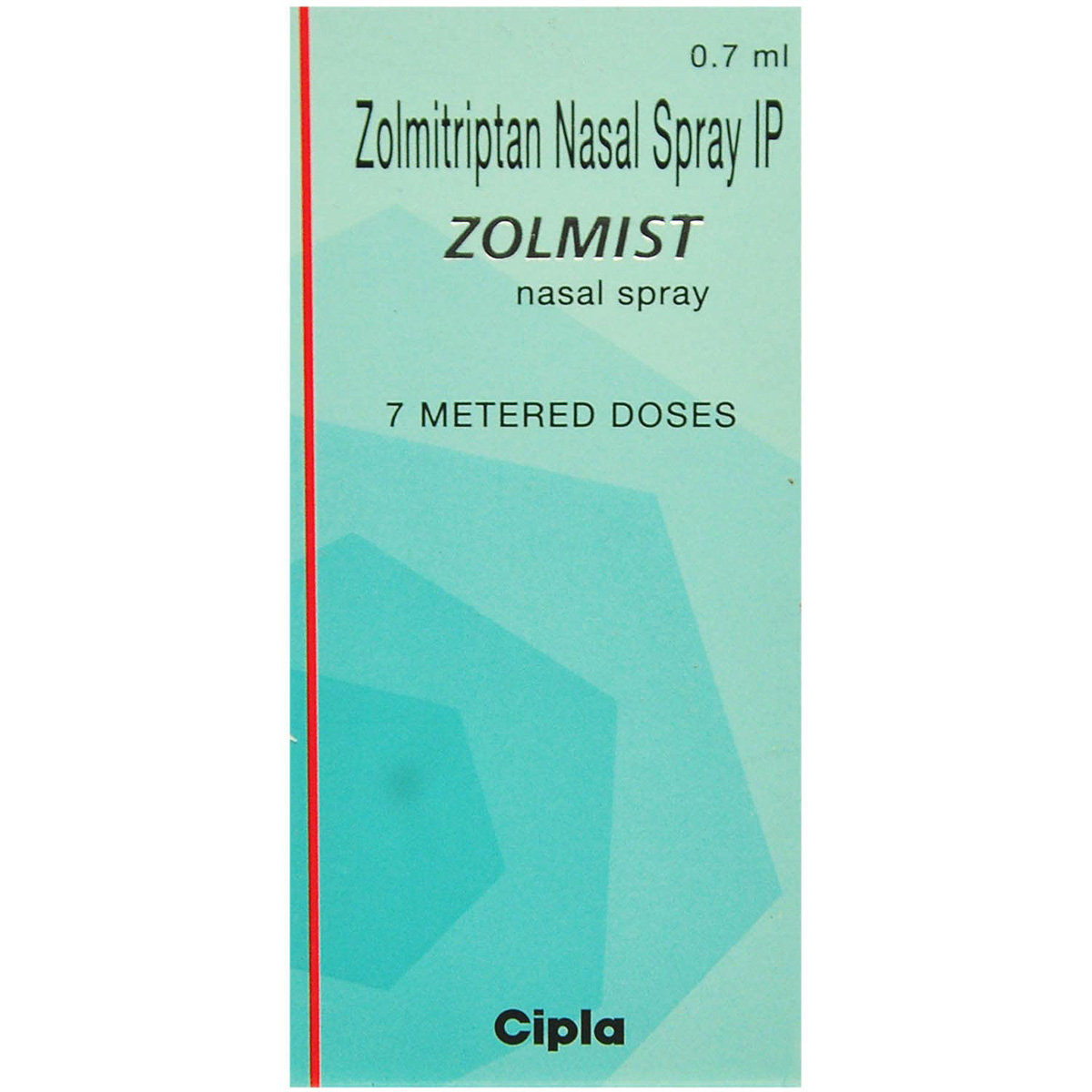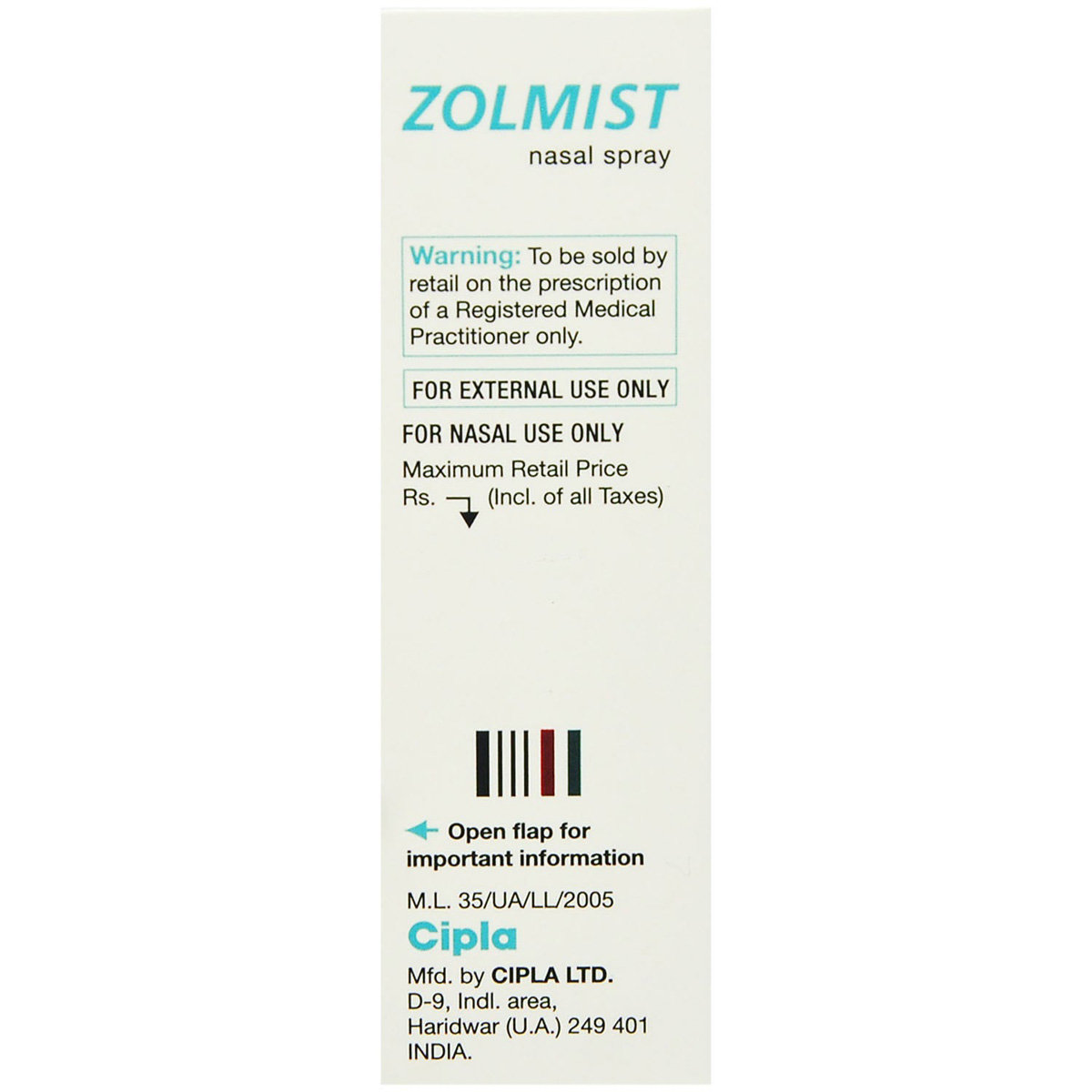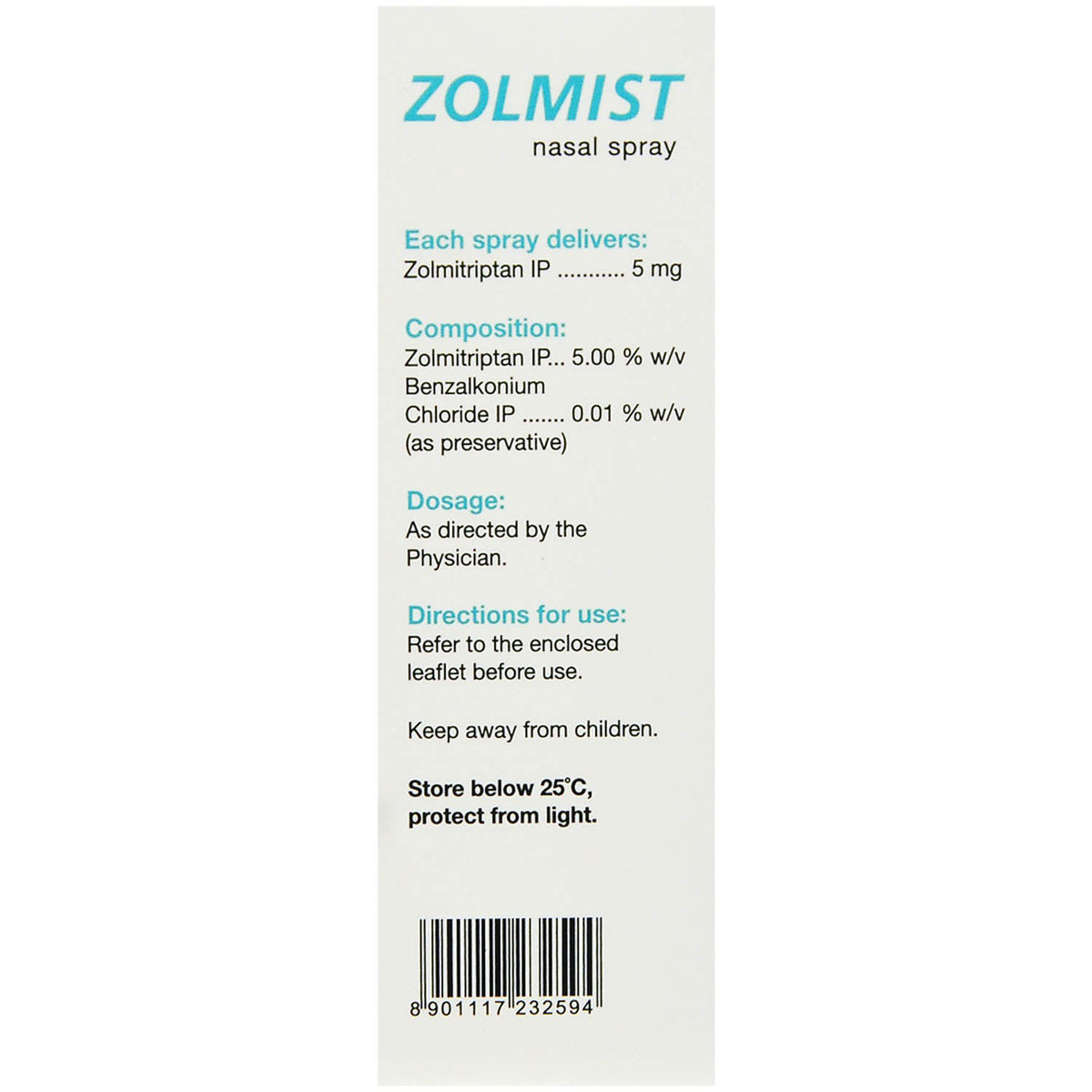Zolmist Nasl Spray 7 mdi



MRP ₹737
(Inclusive of all Taxes)
₹110.5 Cashback (15%)
know your delivery time
Provide Delivery Location
Composition :
Manufacturer/Marketer :
Consume Type :
Expires on or after :
Return Policy :

Secure Payment

Trusted by 8 Crore Indians

Genuine Products
Therapeutic Class
Country of origin
Manufacturer/Marketer address
Author Details
We provide you with authentic, trustworthy and relevant information
Disclaimer
Alcohol
Safe if prescribed
Avoid consumption of alcohol while on treatment with Zolmist Nasl Spray 7 mdi as it may increase drowsiness.
Pregnancy
Consult your doctor
Zolmist Nasl Spray 7 mdi is not recommended during pregnancy. Inform your doctor if you are pregnant or suspect pregnancy. Your doctor will weigh the benefits and potential risks before prescribing Zolmist Nasl Spray 7 mdi.
Breast Feeding
Consult your doctor
Zolmist Nasl Spray 7 mdi is not recommended in breastfeeding unless clearly necessary. Inform your doctor if you are a nursing mother. If this medicine is used during nursing, the calcium levels of you and your child need to be monitored. Before taking this injection, all the benefits and risks should be discussed with your doctor.
Driving
Safe if prescribed
Zolmist Nasl Spray 7 mdi may cause dizziness and weakness. So, do not drive or operate machinery unless you are alert.
Liver
Consult your doctor
Inform your doctor before receiving Zolmist Nasl Spray 7 mdi if you have a pre-existing or a history of liver disease. Your doctor may adjust the dose or prescribe a suitable alternative based on your condition.
Kidney
Consult your doctor
Inform your doctor before receiving the Zolmist Nasl Spray 7 mdi if you have a pre-existing or a history of kidney conditions. Your doctor may adjust the dose or prescribe a suitable alternative based on your condition.
Children
Safe if prescribed
Zolmist Nasl Spray 7 mdi is not recommended for children as safety and effectiveness were not established.
About Zolmist Nasl Spray 7 mdi
Zolmist Nasl Spray 7 mdi belongs to a class of drugs known as 'antimigraine agents' used to prevent migraine symptoms such as headache, nausea, and vomiting. Migraine is a neurological condition characterized by intense pulsating, throbbing, pounding, debilitating headache, which usually occurs on one side of the head; however, it can occur on both sides or shift. Hormonal changes, stress, bright lights, loud sounds, and certain foods and drinks can trigger migraine headaches.
Zolmist Nasl Spray 7 mdi contains Zolmitriptan. It works by constricting blood vessels around the brain, preventing pain signals from reaching the brain, and preventing the release of certain natural substances that cause pain, nausea, and other migraine symptoms.
Take Zolmist Nasl Spray 7 mdi as prescribed by your doctor. Depending on your medical condition, you are advised to take Zolmist Nasl Spray 7 mdi for as long as your doctor prescribes it. In some cases, you may experience certain common side effects such as a sore or irritated nose, unusual taste in the mouth, tiredness, dizziness and sensitive skin, especially around the nose and a burning or tingling feeling. Most of these side effects do not require medical attention and will resolve gradually over time. However, you are advised to talk to your doctor if you experience these side effects persistently.
Do not take Zolmist Nasl Spray 7 mdi if you are allergic to any of its contents. Inform your doctor if you have had any renal or liver problems, ischemic heart disease, hyperlipidemia (high levels of fat), menopausal disorder, obesity, smoking, cerebrovascular disease, and heart disease. Do not use Zolmist Nasl Spray 7 mdi if you are pregnant or breastfeeding unless prescribed. Zolmist Nasl Spray 7 mdi may cause drowsiness and tiredness, so drive only if you are alert. Zolmist Nasl Spray 7 mdi should not be given to children as safety and effectiveness have not been established. Avoid consuming alcohol along with Zolmist Nasl Spray 7 mdi as it could lead to increased drowsiness.
Uses of Zolmist Nasl Spray 7 mdi
Medicinal Benefits Mweb
Key Benefits
Zolmist Nasl Spray 7 mdi contains Zolmitriptan (anti-migraine medication), which prevents migraine symptoms such as headaches, nausea and vomiting. It works by constricting blood vessels around the brain, preventing pain signals from reaching the brain, and preventing the release of certain natural substances that cause pain, nausea, and other migraine symptoms. Thus, Zolmist Nasl Spray 7 mdi helps effectively treat symptoms of migraine-like headache, nausea and vomiting.
Directions for Use
Side Effects of Zolmist Nasl Spray 7 mdi
- Sore or irritated nose
- Unusual taste in the mouth
- Tiredness
- Dizziness
- Sensitive skin, especially around the nose
- Dry mouth
- Nausea
- Weakness
- Burning or tingling feeling
Drug Warnings
If you are allergic to any of the contents of Zolmist Nasl Spray 7 mdi, do not take it. Inform your doctor if you have a history of renal or liver illness, ischemic heart disease, hyperlipidemia (high levels of fat), menopausal dysfunction, obesity, smoking, cerebrovascular disease, or heart disease. Do not use Zolmist Nasl Spray 7 mdi unless prescribed if you are pregnant or breastfeeding. Zolmist Nasl Spray 7 mdi may cause drowsiness and fatigue, so only drive if you are awake. Children should not be given this medicine because its safety and effectiveness have not been proven. Consuming alcohol while taking Zolmist Nasl Spray 7 mdi may cause drowsiness.
Drug-Drug Interactions
Drug-Drug Interactions
Login/Sign Up
Using Zolmist Nasl Spray 7 mdi together with mirtazapine can increase the risk of a rare but serious condition called serotonin syndrome (A condition resulting from the accumulation of high levels of serotonin in the body. Serotonin is especially a mood stabilizer).
How to manage the interaction:
Although there is a possible interaction between Mirtazapine and Zolmist Nasl Spray 7 mdi, you can take these medicines together if prescribed by your doctor. If you notice any of these signs - like confusion, shaking, or stomach discomfort - it's a good idea to reach out to a doctor right away. Do not stop using any medications without talking to a doctor.
Combining Rizatriptan with Zolmist Nasl Spray 7 mdi can increase the risk of high blood pressure.
How to manage the interaction:
Taking Rizatriptan with Zolmist Nasl Spray 7 mdi is not recommended as it can possibly result in an interaction, it can be taken if your doctor has advised it. However, consult your doctor immediately If you experience symptoms such as severe abdominal pain, nausea, vomiting, numbness or tingling, muscle pain or weakness, blue or purple discoloration of fingers or toes, pale or cold skin, chest pain or tightness, irregular heartbeat, severe headache, shortness of breath, blurred vision, confusion, and/or slurred speech. Do not discontinue any medications without consulting a doctor.
Combining Tranylcypromine with Zolmist Nasl Spray 7 mdi can increase the risk of serotonin syndrome.
How to manage the interaction:
Taking Tranylcypromine with Zolmist Nasl Spray 7 mdi is not recommended as it can possibly result in an interaction, it can be taken if your doctor has advised it. If you notice any of these symptoms like confusion, hallucination, seizure, extreme changes in blood pressure, increased heart rate, fever, excessive sweating, shivering or shaking, blurred vision, muscle spasm or stiffness, tremor, incoordination, stomach cramp, nausea, vomiting, and diarrhea, it's a good idea to reach out to your doctor right away. Do not discontinue any medications without first consulting your doctor.
Taking Duloxetine with Zolmist Nasl Spray 7 mdi can increase the risk of serotonin syndrome(a condition in which a chemical called serotonin increase in your body).
How to manage the interaction:
Although taking Duloxetine with Zolmist Nasl Spray 7 mdi can possibly result in an interaction, they can be taken together if prescribed by a doctor. However, consult a doctor if you experience confusion, fever, excessive sweating, shivering, pain in the muscles, stomach cramps, nausea, vomiting, and diarrhoea. Do not discontinue any medications without consulting your doctor.
Taking Zolmist Nasl Spray 7 mdi with Pentazocine can increase the risk of serotonin syndrome(a condition in which a chemical called serotonin increase in your body).
How to manage the interaction:
Co-administration of Pentazocine with Zolmist Nasl Spray 7 mdi can possibly result in an interaction, but can be taken together if prescribed by a doctor. However, consult a doctor if you experience confusion, hallucination(seeing and hearing things that do not exist), fits, blood pressure alteration, increased heart rate, fever, excessive sweating, shivering or shaking, blurred vision, pain in the muscles or stiffness, incoordination, stomach cramps, nausea, vomiting, and diarrhea. Do not discontinue any medications without consulting your doctor.
Combining Zolmist Nasl Spray 7 mdi with Amitriptyline can increase the risk of serotonin syndrome.(A condition in which a chemical called serotonin builds up in your body).
How to manage the interaction:
Although using Zolmist Nasl Spray 7 mdi and Amitriptyline together may cause an interaction, they can be taken if prescribed by a doctor. Consult a doctor if you have symptoms such as confusion, hallucination, fits, blood pressure alteration, increased heart rate, fever, excessive sweating, shivering or shaking, blurred vision, pain in the muscles or stiffness, incoordination, stomach cramps, nausea, vomiting, and diarrhea. Inform a doctor if you have recently taken amitriptyline. Do not discontinue any medications without consulting a doctor.
Co-administration of Dextromethorphan and Zolmist Nasl Spray 7 mdi may increase the risk of serotonin syndrome (A condition in which a chemical called serotonin builds up in your body).
How to manage the interaction:
Although there is a possible interaction between Dextromethorphan and Zolmist Nasl Spray 7 mdi, you can take these medicines together if prescribed by a doctor. However, if you experience symptoms such as seizures (fits), extreme changes in blood pressure, confusion, hallucination, increased heart rate, fever, excessive sweating, shivering or shaking, tremors, incoordination, blurred vision, muscle spasm or stiffness, nausea, vomiting, stomach cramp, and diarrhea, contact a doctor immediately. Do not discontinue the medication without consulting a doctor.
Taking Escitalopram with Zolmist Nasl Spray 7 mdi can increase the risk of serotonin syndrome.
How to manage the interaction:
There may be a possibility of interaction between Escitalopram and Zolmist Nasl Spray 7 mdi, but it can be taken if prescribed by a doctor. However, contact your doctor if you experience confusion, hallucination, seizure, increased heart rate, fever, sweating, shivering, blurred vision, muscle spasms, stiffness, trouble moving, stomach cramps, nausea, vomiting, or diarrhea. Do not stop using any medications without a doctor's advice.
Using Granisetron together with Zolmist Nasl Spray 7 mdi can increase the risk of a serious condition called serotonin syndrome (A condition resulting from the accumulation of high levels of serotonin in the body. Serotonin is a mood stabilizer).
How to manage the interaction:
Although taking Granisetron and Zolmist Nasl Spray 7 mdi together can cause an interaction, it can be taken if a doctor has suggested it. However, if you experience any of the following symptoms: confusion, hallucination, seizure, extreme changes in blood pressure, increased heart rate, fever, excessive sweating, shivering or shaking, blurred vision, muscle spasm or stiffness, tremor, incoordination, stomach cramp, nausea, vomiting, and diarrhea, consult a doctor. Do not discontinue any medications without consulting a doctor.
Co-administration of Zolmist Nasl Spray 7 mdi and Desvenlafaxine might raise serotonin hormone levels in the body, affecting the brain and nerve cells. Increased serotonin hormone can lead to severe side effects.
How to manage the interaction:
Co-administration of Zolmist Nasl Spray 7 mdi and Desvenlafaxine can lead to an interaction, but it can be taken if advised by your doctor. However, if you experience any symptoms like confusion, hallucination, seizure, increased heart rate, fever, excessive sweating, shivering or shaking, blurred vision, muscle spasm or stiffness, tremors, incoordination, stomach cramps, nausea, vomiting, and diarrhea, consult the doctor immediately. Do not stop using any medications without a doctor's advice.
Drug-Food Interactions
Drug-Food Interactions
Login/Sign Up
Drug-Diseases Interactions
Drug-Diseases Interactions
Login/Sign Up
Drug-Drug Interactions Checker List
- FROVATRIPTAN
- DULOXETINE
- AMOXAPINE
- DOXEPIN
- NORTRIPTYLINE
- ONDANSETRON
- TRAMADOL
Habit Forming
Diet & Lifestyle Advise
- Practice meditation and yoga. This relieves tension and gives relaxation. Maintain a consistent sleep schedule to increase the quality of your sleep. Massage your scalp to relieve tension.
- Lie down in a quiet, dark room. Place a cold cloth over your forehead or neck.
- Avoid smoking, alcohol and caffeinated drinks. Stay hydrated. Drink plenty of fluids. Maintaining a healthy diet and exercising regularly helps improve overall health and boost self-esteem.
- Learn what triggers your migraine and try avoiding them. Learn relaxation skills as they help in reducing stress.
- Avoid bright lights, loud noise and extreme temperatures.

Have a query?
Buy best Ear, Nose & Oropharynx products by
Entod Pharmaceuticals Ltd
Cipla Ltd
NuLife Pharmaceuticals
Nri Vision Care India Ltd
Lincoln Pharmaceuticals Ltd
Glenmark Pharmaceuticals Ltd
Macleods Pharmaceuticals Ltd
Pristine Pearl Pharma Pvt Ltd
Centaur Pharmaceuticals Pvt Ltd
Dr Reddy's Laboratories Ltd
Lupin Ltd
Zydus Healthcare Ltd
Indoco Remedies Ltd
Intas Pharmaceuticals Ltd
Mankind Pharma Pvt Ltd
GlaxoSmithKline Pharmaceuticals Ltd
Leeford Healthcare Ltd
Megma Healthcare Pvt Ltd
Sapient Laboratories Pvt Ltd
Sun Pharmaceutical Industries Ltd
Zuventus Healthcare Ltd
Zydus Cadila
Auskincare Formualation Pvt Ltd
Alkem Laboratories Ltd
Bell Pharma Pvt Ltd
Chethana Pharmaceuticals
Dwd Pharmaceuticals Ltd
German Remedies Ltd
Kaizen Drugs Pvt Ltd
Torque Pharmaceuticals Pvt Ltd
Vilco Laboratories Pvt Ltd
Avilius Neutracare
Biochem Pharmaceutical Industries Ltd
Blubell Pharma
Delcure Life Sciences Ltd
Eris Life Sciences Ltd
Kavach 9 Pharma & Research Pvt Ltd
Medishri Healthcare Pvt Ltd
NVK Pharma
Optho Remedies Pvt Ltd
Ordain Health Care Global Pvt Ltd
Respionix Healthcare Pvt Ltd
Troikaa Pharmaceuticals Ltd
Xseed Pharma
Abbott India Ltd
Atopic laboratories Pvt Ltd
Cadila Pharmaceuticals Ltd
Clyde Pharmaceutical Pvt Ltd
East India Pharmaceutical Works Ltd
FDC Ltd
Incus Pharmaceuticals Pvt Ltd
Meridian Enterprises Pvt Ltd
Micro Labs Ltd
Morepen Laboratories Ltd
Nextgen Healthcare
Novalab Healthcare Pvt Ltd
Ocuris Pharmaceuticals Pvt Ltd
Precept Pharma
Salvador Visiontech Pvt Ltd
Sunways (India) Pvt Ltd
Timon Pharmaceuticals Pvt Ltd
Unison Pharmaceuticals Pvt Ltd
Aar Ess Remedies Pvt Ltd
Adley Formulations
Ajanta Pharma Ltd
Alercon Pharma Pvt Ltd
Apex Laboratories Pvt Ltd
Aver Pharmaceuticals Pvt Ltd
BMW Pharmaco India Pvt Ltd
Bio Warriors Pharmaceucticals Pvt Ltd
Casca Remedies Pvt Ltd
Elan Pharma India Pvt Ltd
Elivia Life Sciences Pvt Ltd
Elkos Healthcare Pvt Ltd
Floreat Medica Pvt Ltd
Healthgate Pvt Ltd
Ikon Remedies Pvt Ltd
Ipca Laboratories Ltd
Koye Pharmaceuticals Pvt Ltd
Lividus Pharmaceuticals Pvt Ltd
Orn Remedies Pvt Ltd
Rosa Lifesciences
Siloam Pharmaceuticals Pvt Ltd
Sitnez Biocare Pvt Ltd
Srigan Anatto Care Pvt Ltd
Uniza Healthcare Llp
Vatican Life Sciences Pvt Ltd
Welgenic Pharma
Wellok Pharma
West Coast Pharmaceuticals Pvt Ltd
Win Medicare Ltd
Zee Laboratories Ltd
Abyss Pharma Pvt Ltd
Accent Pharmaceuticals & Diagnostics
Alembic Pharmaceuticals Ltd
Alencure Biotech Pvt Ltd
Austere
Bacans Biotech Pvt Ltd
Biopolis Life Sciences Pvt Ltd
Biosys Medisciences



